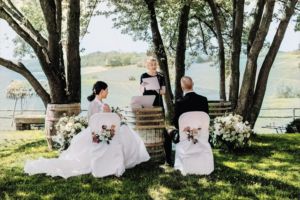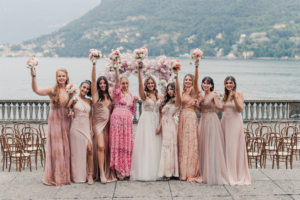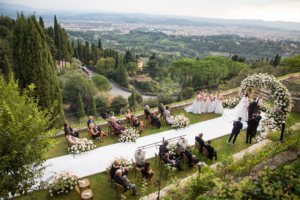The role of a wedding lay celebrant has become increasingly popular in recent years as an alternative to traditional religious ceremonies. A lay celebrant is a non-religious person who leads the ceremony and performs the functions of a priest or religious minister. However, over time, different nuances have emerged within this role. Specifically, two of these nuances are represented by lay celebrant and lay-humanist celebrant.
Let’s explore the differences between these two types of secular celebrants.
Lay Celebrant or Lay-Humanist Celebrant?
A lay celebrant is a person who leads the ceremony without any religious affiliation. It can be a friend, relative, or an external person with a deep understanding of the couple and their love story. The lay celebrant is responsible for writing and conducting the ceremony, including speeches and vows, and coordinating any musical performances with the ceremony’s soundtrack, whether it’s live musicians or a DJ.
On the other hand, a humanist celebrant focuses on humanist philosophy, which promotes humanity and its creative expression without any religious belief or affiliation. The lay-humanist celebrant seeks to create a ceremony that is based on humanist values such as equality, tolerance, and human dignity and may also provide counseling to the marrying couple based on these values.
One of the main differences between these two types of lay celebrants is their approach to the ceremony. Both figures focus on the couple and their relationship, but the lay-humanist celebrant also seeks to create a ceremony that reflects humanist values and encourages the community to celebrate humanity.
What is the specific training for Lay Celebrant and Lay-Humanist Celebrant?
Another difference between these two types of lay celebrants is their training. While a lay celebrant can be anyone with sufficient knowledge of the couple and their needs, a lay-humanist celebrant usually requires specific training. For example, the American Humanist Association offers certification for secular humanist celebrants, which requires a training course and participation in a series of ceremonies under the guidance of an experienced celebrant.
In Italy there are training courses organized and promoted by various associations, including Uaar (Associazione Atei Agnostici Razionalisti) and Federcelebranti.
I myself am part of the group of trainers for Uaar, with the project “Cerimonie Uniche.”
Other differences
Another significant difference between a lay celebrant and a lay-humanist celebrant is that the lay-humanist celebrant is often an advocate for civil rights and social justice. This means that the lay-humanist celebrant may incorporate moments of reflection into the ceremony to promote social justice and encourage the community to support the rights of minorities. For example, the lay-humanist celebrant may talk about the need to combat racial discrimination or defend the rights of LGBTQ+ individuals. In this way, the lay-humanist celebrant may seize the opportunity of the celebratory moment to promote social justice and equality, of course, upon the explicit request and desire of the couple at the center of the ceremony, who always remains the focus of the celebration.
The couple and their love story are always the main focus of the ceremony.
Furthermore, the lay-humanist celebrant often has specific training in humanist philosophy and may also be an activist for promoting humanism. In contrast, a lay celebrant may have general or non-specific training and may not be involved in activism or promoting a particular movement or philosophy.
Another difference that can arise between the two types of lay celebrants is the management of the ceremony. While a lay celebrant focuses on the couple and their love story, the lay-humanist celebrant seeks to involve the community in the ceremony as well. This could include the participation of friends and family in the ceremony, such as asking them to read poems or perform music. In this way, the lay-humanist celebrant aims to create an inclusive and engaging ceremony for the community.
In conclusion, the choice between a lay celebrant and a lay-humanist celebrant depends on the preferences and needs of the couple, as well as the values they wish to promote during the ceremony. Both types of lay celebrants offer a personalized and meaningful ceremony, but they differ in their approach and the values they promote.
Choosing a lay celebrant or a lay-humanist celebrant can be the ideal choice for couples who want a personalized and meaningful ceremony but do not want a traditional religious ceremony. Both the lay celebrant and the lay-humanist celebrant offer a wide range of possibilities and can create a ceremony that reflects the couple’s desires and values.
Please feel free to contact me!
As for myself, in my ceremonies, I always place the couple and their love story at the center of everything. In my personal and educational journey, I always remain attentive to humanistic and social issues that may be important to the couples who come to me, and if it is their desire, I try to add reflections, thoughts, and words that give a broader and more universal scope to their ceremony.
If you wish, I am available for a free call or video call to discuss your ceremony and together evaluate the best possible option for your dream wedding.




